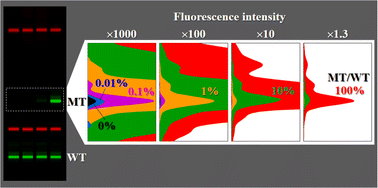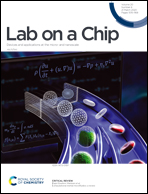Highly sensitive mutation quantification by high-dynamic-range capillary-array electrophoresis (HiDy CE)†
Abstract
A simple and robust ultra-small four-color-fluorescence detection system was developed by integrating its components, namely, a four-capillary array, an injection-molded-plastic four-lens array, a four-dichroic-mirror array, and a CMOS sensor, as one device. The developed system was applied to a high-dynamic-range capillary-array electrophoresis (HiDy CE) to quantify a rare EGFR mutant (MT) of exon 19 deletion in a large excess of EGFR wild type (WT). Samples with serially diluted MT and constant-concentration WT were co-amplified by competitive PCR and subjected to HiDy CE. The MT peak in each electropherogram was then compared to the WT peak. As a result, MT was quantified with high-sensitivity (LOD of 0.004% MT/WT) and four-orders-of-magnitude dynamic range (0.01–100% MT/WT) by HiDy CE. Moreover, compared with existing methods, HiDy CE achieves higher speed, higher sample throughput, and lower consumable cost per sample. It has therefore great potential to be used in clinical practice.



 Please wait while we load your content...
Please wait while we load your content...